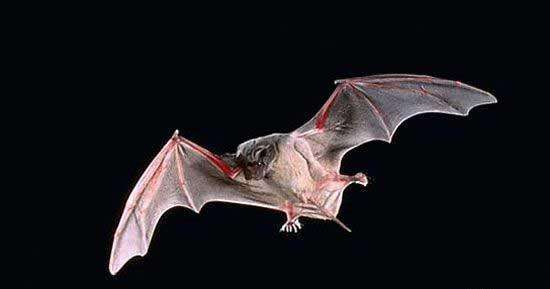(单词翻译:单击)
听力文本
This is Scientific American — 60-Second Science. I'm Jason Goldman.
The little brown bat was once abundant in the eastern U.S. But within the last 15 years, a fungus called Pseudogymnoascus destructans infiltrated a cave in upstate New York. This fungus causes what's called white-nose syndrome in bats.
The illness has now spread throughout North America, causing widespread bat die-offs. But recently, little brown bats in New York have stopped declining. In fact, their numbers are actually going back up.
"That was exciting, but we had no idea how these bats were persisting with the disease." Harvard University epidemiologist Kate Langwig.
"Little brown bats, during the fall swarm around hibernacula entrances. During that time period they're active, and they're feeding and fattening for winter, they also mate during that time period. Then they go into hibernation, and that's really when infection peaks. Winter is the time period in which white nose syndrome is happening to bats."
To understand how the New York bats were surviving, Langwig and her team compared them to bats from Illinois and Virginia, in colonies that are still experiencing the initial mass die-offs. They wanted to see whether the New York bats had simply found a way to tolerate the presence of the pathogen, or whether they'd actually developed resistance to the infection.

"So we found that when bats first return to hibernacula, they still become infected. Both in areas where the fungus has recently invaded as well as in areas where the fungus is established, bats become infected at the same time. And then in both places we see the fungus begin to grow and start to increase. However in areas where the disease has been for a number of years, what we find is that the fungus then reaches kind of a plateau."
So in New York, the disease ramps up starting in the early winter but then the fungus stops spreading. In Illinois and Virginia, it just keeps on growing.
"It suggests that the bats are somehow actually limiting the growth of the fungus on their skin."
Langwig still doesn't know how the bats are fighting off the disease. She also wants to find out why their resistance doesn't show up until so late in the winter. Does the response wait until it hits some threshold? Do the bats' immune systems just take longer to boot up during hibernation?
And last, of course, she wants to know what lessons bat researchers can learn from this population that might help them save other types of bats in other places.
"These results, that little brown bats have developed resistance, are really encouraging to think about. We could see bats abundant once again in the Northeast."
Thanks for listening for Scientific American — 60-Second Science Science. I'm Jason Goldman.
参考译文
这里是科学美国人——60秒科学。我是杰森·古德曼。
过去15年,美国东部地区曾有大量的小型棕蝙蝠,但是一种名为假裸囊菌属锈腐柱隔孢的真菌渗透到了纽约的一个山洞里。这种真菌导致蝙蝠患上了白鼻综合征。
这种疾病现在已经蔓延到整个北美洲,导致蝙蝠大量死亡。不过最近,纽约小型棕蝙蝠的数量已经停止下降。实际上,它们的数量已经开始回升。
“这真令人兴奋,可是我们不知道这些蝙蝠是怎么与疾病做斗争的。”哈佛大学流行病学家凯特·朗威格说。
“小型棕蝙蝠在秋天准备进入冬眠。在此期间它们非常活跃,它们要为冬季囤积脂肪,同时它们也会在这段时间进行交配。然后它们就进入冬眠阶段,这也是感染的高峰期。冬季也是蝙蝠患上白鼻子综合症的时期。”
为了了解纽约蝙蝠如何生存,朗威格和她的团队对来自伊利诺伊州和弗吉尼亚州的蝙蝠进行了比较分析,这些地区的蝙蝠仍有大量死亡的情况出现。他们想知道纽约蝙蝠只是找到了可以容忍病原体的方法,还是它们真的对感染产生了抵抗力。
“我们发现,当蝙蝠首次冬眠时,它们仍然会被感染。在真菌最近入侵的地方和真菌产生的地方,蝙蝠会同时被感染。然后我们看到这两个地方的真菌都开始生长并逐渐增加。但是,在疾病已经肆虐很多年的地方,我们发现真菌已经进入停滞期。”
就纽约来说,这种疾病在初冬开始出现,但是真菌却停止传播。而在伊利诺伊州和弗吉尼亚州,真菌却在一直增长。
“这表明蝙蝠实际上已经限制了真菌在它们皮肤上的生长。”
但是朗威格还不知道蝙蝠是怎么抵抗疾病的。她还想弄清楚它们的抵抗力为什么在冬天才出现。这种应对是要等到某个阈值出现才起作用吗?蝙蝠的免疫系统是不是在冬眠期间需要更长的启动时间?
最后,她想知道研究人员能从蝙蝠对抗疾病中学习到什么经验,这种经验也许可以帮助他们拯救在其他地方生活的其他类型的蝙蝠。
“这些结果表明,小型棕蝙蝠产生了抗体,这真的令人欢心鼓舞。我们可以看到东北部地区的蝙蝠数量再次丰富起来。 ”
谢谢大家收听科学美国人——60秒科学。我是杰森·古德曼。
译文为可可英语翻译,未经授权请勿转载!
重点讲解
重点讲解:
1. happen to (尤指不愉快的事)发生(在…身上);(某人)遭到;遇到;
例句:Things always seem to happen to him.
他好像总不顺利。
2. fight off 抵抗,战胜(疾病);摆脱(不快);
例句:Unfortunately these drugs are quite toxic and hinder the body's ability to fight off infection.
可惜的是,这些药物毒性很大,会削弱身体对感染的抵抗力。
3. show up 出现;露面;
例句:Difficulties can show up a person's best qualities.
困难能使一个人的一些最好的品质显现出来。
4. boot up 启动;
例句:The system will then use these same rules the next time it boots up.
下次系统启动时就会使用这些规则了。


